Opening 16/05 - 16/05 - 31/07, 2019
-
Runo Lagomarsino
We are each other’s air
“We need other kinds of stories,” says Donna Haraway as she faces the camera in Fabrizio Terranova’s Storytelling for Earthly Survival (2016) and suggests a wide horizon of possibilities about how these other stories may feel, look or sound like. To balance our earthly living, weak stories are to be rendered strong while dominant stories to be rendered weak. Runo Lagomarsino’s practice is weaved around a strong need for other kinds of stories shaped by persisting presence in the face of dominant narratives of power.
The artist is very aware of how language is a site of empowerment and a site of enslavement at the same time. In his approach, materiality become tools and environments of storytelling; they are transformed with frictions as they witness presence. Lagomarsino names his new solo exhibition for Francesca Minini as We are each other’s air poetically highlighting the dilemma of presence and impossibility of containment, which air as a life element refers to. The new works he realised for the exhibition experiment with containment in various forms and elements, collapsing the boundaries between materiality and immateriality on different realms of politics and poetics. His sharp and idiosyncratic sense of humour cross-referencing double-faced stories of modernity is at work as usual.
Lagomarsino often fractures and plays with the historical narrative of enlightenment which appears in the materiality and symbolism of natural and artificial light in works such as Trans-Atlantic (2010-11) where he had newspapers exposed to sun regularly during a Transatlantic sea travel; Stolen Light (Abstracto en Dorado) (2013) where he displayed stolen lightbulbs and neons he took from the Ethnographic Museum in Berlin and Pergamon (A Place in Things) (2014) where he reunited more than one hundred lighting devices that were previously used in the Pergamon Museum in Berlin, systematically laid out on a plinth.
Enlightenment, defined as the age of reason in Europe, advocated ideals such as liberty, progress, tolerance, constitutional government, and separation of church and state, and produced the basis of modernity as understood today. For the artist, modernity and its ideals erected through domination of labour, wealth and resources appropriated from colonised lands and communities reduces the knowledge and reality of the worlds we live in to a singular dominant narrative.
Poet and philosopher Édouard Glissant rightfully points out that from the perspective of enlightened Western thought understanding people and ideas requires being measured and reduced: “In order to understand and thus accept you, I have to measure your solidity with the ideal scale providing me with grounds to make comparisons and, perhaps, judgments. I have to reduce.”
When there is reduction, there is no relation. Yet Lagomarsino’s playful reduction of enlightenment to light bulb and its artificial light reveals the reductive Western perspective in relation to the rest of the world and relates history with contemporary in intrinsic ways.
We live on the ruins of previous futures (2015-2019) is the next passage of the other kind of story. Comprised of glass jars, burned and broken light bulbs collected from the apartments the artist and his family have lived in during the last four years in different countries and continents, the work brings the same institution of enlightenment into the domestic space addressing what connects institutional sublime and everyday mundane ideologically. In jarring already used, burned and broken light bulbs, Lagomarsino alludes to the process of demystification and remystification present in Lampada Annuale (1966) by one of his reference artists, Alighiero Boetti, where a single, outsized light bulb in a mirror-lined wooden box, randomly switches on for eleven seconds each year.
Memorialisation of memories that cannot be contained is very present in Air d’exil (we smoke for the dead, we store for the dead, but they are not dead) (2019). Coloniality of power is a recurring condition in contemporary Latin American societies shaping the living legacy of colonialism in the form of social discrimination and political interventionism. Coming from a family forced to migrate to Argentina from Italy before the heat of colonial World War I and forced to leave Argentina with military dictatorship in 1976 to come to Sweden, Lagomarsino is very aware of the forms of fascism the colonial mind is produced by and continues to produce to sustain itself.
Thus, the dead are never left in peace. Hand blown glass bowls, inspired by Marcel Duchamp’s 1964 dated Air de Paris, filled with invisible smoke of Argentinian Jockey Club cigarettes from 1976 produce an eerie feeling of loss and losing oneself at the same time. With the mostly invisible stories of death and exile they carry a kind of melancholia that cannot be easily identified.
When Richard Serra made his famous Hand Catching Lead in 1968 inspired by Yvonne Rainer’s Hand Movie (1967-68) which showed a finger exercise, Rosalind Krauss framed the hand in action, trying, failing and trying again to get a hold of material in a repetitive cycle as a gesture of self-reflection and self-reference. The question of how art histories are written by whom and for whom comes forward in America I Use Your Name in Vain (2019). What kind of models does Western modern art history propose to other artists who are shaped by different contexts of power?
The iconic hand of minimalist artist claiming its material humourously translates into the precarious hand of artist trying to hold the inner metal circle of 1 Brasilian Reais, one of the most slippery currencies in world economy, demanding a self-reflection from those who write art histories. On the other side, the film can be read as a condition report of the ongoing loss of existing resources in colonised lands from the very past until today. And it points out howthese two issues need to be read in relation, rather than treated as separate situations in reduction. While inner coins drop on the floor, outer gold dripped circles are united together on a big steel circle in The Infernal Circles (2019).
“We need other kinds of stories,” says Donna Haraway as she faces the camera in Fabrizio Terranova’s Storytelling for Earthly Survival (2016) and suggests a wide horizon of possibilities about how these other stories may feel, look or sound like. To balance our earthly living, weak stories are to be rendered strong while dominant stories to be rendered weak. Runo Lagomarsino’s practice is weaved around a strong need for other kinds of stories shaped by persisting presence in the face of dominant narratives of power.
The artist is very aware of how language is a site of empowerment and a site of enslavement at the same time. In his approach, materiality become tools and environments of storytelling; they are transformed with frictions as they witness presence. Lagomarsino names his new solo exhibition for Francesca Minini as We are each other’s air poetically highlighting the dilemma of presence and impossibility of containment, which air as a life element refers to. The new works he realised for the exhibition experiment with containment in various forms and elements, collapsing the boundaries between materiality and immateriality on different realms of politics and poetics. His sharp and idiosyncratic sense of humour cross-referencing double-faced stories of modernity is at work as usual.
Lagomarsino often fractures and plays with the historical narrative of enlightenment which appears in the materiality and symbolism of natural and artificial light in works such as Trans-Atlantic (2010-11) where he had newspapers exposed to sun regularly during a Transatlantic sea travel; Stolen Light (Abstracto en Dorado) (2013) where he displayed stolen lightbulbs and neons he took from the Ethnographic Museum in Berlin and Pergamon (A Place in Things) (2014) where he reunited more than one hundred lighting devices that were previously used in the Pergamon Museum in Berlin, systematically laid out on a plinth.
Enlightenment, defined as the age of reason in Europe, advocated ideals such as liberty, progress, tolerance, constitutional government, and separation of church and state, and produced the basis of modernity as understood today. For the artist, modernity and its ideals erected through domination of labour, wealth and resources appropriated from colonised lands and communities reduces the knowledge and reality of the worlds we live in to a singular dominant narrative.
Poet and philosopher Édouard Glissant rightfully points out that from the perspective of enlightened Western thought understanding people and ideas requires being measured and reduced: “In order to understand and thus accept you, I have to measure your solidity with the ideal scale providing me with grounds to make comparisons and, perhaps, judgments. I have to reduce.”
When there is reduction, there is no relation. Yet Lagomarsino’s playful reduction of enlightenment to light bulb and its artificial light reveals the reductive Western perspective in relation to the rest of the world and relates history with contemporary in intrinsic ways.
We live on the ruins of previous futures (2015-2019) is the next passage of the other kind of story. Comprised of glass jars, burned and broken light bulbs collected from the apartments the artist and his family have lived in during the last four years in different countries and continents, the work brings the same institution of enlightenment into the domestic space addressing what connects institutional sublime and everyday mundane ideologically. In jarring already used, burned and broken light bulbs, Lagomarsino alludes to the process of demystification and remystification present in Lampada Annuale (1966) by one of his reference artists, Alighiero Boetti, where a single, outsized light bulb in a mirror-lined wooden box, randomly switches on for eleven seconds each year.
Memorialisation of memories that cannot be contained is very present in Air d’exil (we smoke for the dead, we store for the dead, but they are not dead) (2019). Coloniality of power is a recurring condition in contemporary Latin American societies shaping the living legacy of colonialism in the form of social discrimination and political interventionism. Coming from a family forced to migrate to Argentina from Italy before the heat of colonial World War I and forced to leave Argentina with military dictatorship in 1976 to come to Sweden, Lagomarsino is very aware of the forms of fascism the colonial mind is produced by and continues to produce to sustain itself.
Thus, the dead are never left in peace. Hand blown glass bowls, inspired by Marcel Duchamp’s 1964 dated Air de Paris, filled with invisible smoke of Argentinian Jockey Club cigarettes from 1976 produce an eerie feeling of loss and losing oneself at the same time. With the mostly invisible stories of death and exile they carry a kind of melancholia that cannot be easily identified.
When Richard Serra made his famous Hand Catching Lead in 1968 inspired by Yvonne Rainer’s Hand Movie (1967-68) which showed a finger exercise, Rosalind Krauss framed the hand in action, trying, failing and trying again to get a hold of material in a repetitive cycle as a gesture of self-reflection and self-reference. The question of how art histories are written by whom and for whom comes forward in America I Use Your Name in Vain (2019). What kind of models does Western modern art history propose to other artists who are shaped by different contexts of power?
The iconic hand of minimalist artist claiming its material humourously translates into the precarious hand of artist trying to hold the inner metal circle of 1 Brasilian Reais, one of the most slippery currencies in world economy, demanding a self-reflection from those who write art histories. On the other side, the film can be read as a condition report of the ongoing loss of existing resources in colonised lands from the very past until today. And it points out howthese two issues need to be read in relation, rather than treated as separate situations in reduction. While inner coins drop on the floor, outer gold dripped circles are united together on a big steel circle in The Infernal Circles (2019).
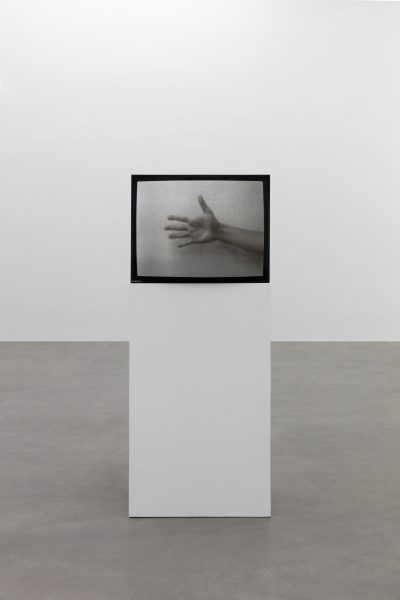 America I use your name in vain, 201916 mm film transferred to HD with sound, 3,12 min, 125 coins
America I use your name in vain, 201916 mm film transferred to HD with sound, 3,12 min, 125 coins
Edition of 3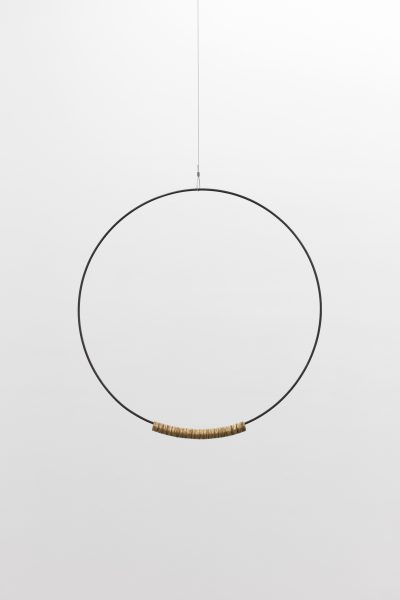 The Infernal Circles, 2019125 One Real coins, metal
The Infernal Circles, 2019125 One Real coins, metal
67×65×2,6 cm
Edition of 3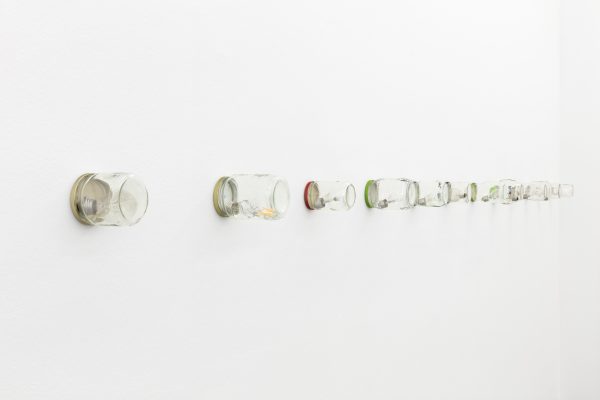 We are each other’s air, 2019Exhibition view at Francesca Minini, Milan
We are each other’s air, 2019Exhibition view at Francesca Minini, Milan
Ph. Andrea Rossetti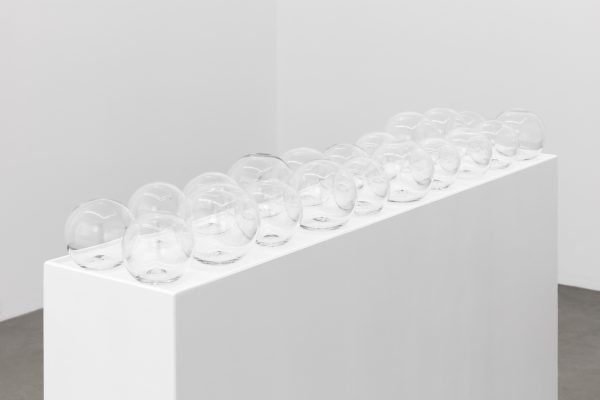 Air d’exil (we smoke for the dead, we store for the dead, but they are not dead), 201920 hand blown glass globes containing smoke from Argentinian Jockey Club 1976
Air d’exil (we smoke for the dead, we store for the dead, but they are not dead), 201920 hand blown glass globes containing smoke from Argentinian Jockey Club 1976
105×105×22,5 cm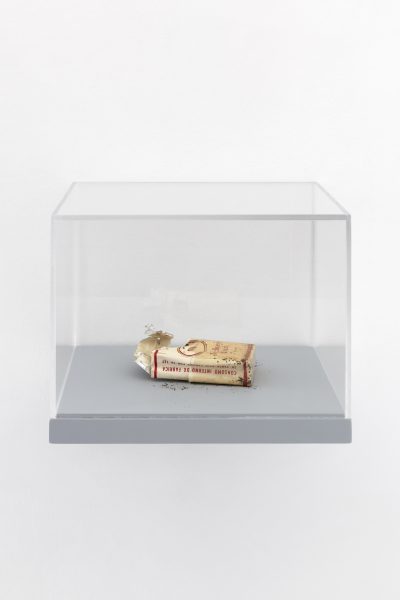 Jockey Club, 2019smoked packet of cigarettes
Jockey Club, 2019smoked packet of cigarettes
17×23×20 cm

























